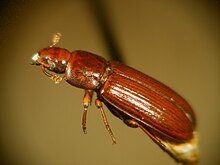| Flour beetles | |
|---|---|

| |
| Tribolium castaneum | |
| Scientific classification | |
| Domain: | Eukaryota |
| Kingdom: | Animalia |
| Phylum: | Arthropoda |
| Class: | Insecta |
| Order: | Coleoptera |
| Superfamily: | Tenebrionoidea |
| Family: | Tenebrionidae |
| Genera | |
Flour beetles are members of several darkling beetle genera including Tribolium and Tenebrio. They are pests of cereal silos and are widely used as laboratory animals, as they are easy to keep. The flour beetles consume wheat and other grains, are adapted to survive in very dry environments, and can withstand even higher amounts of radiation than cockroaches.[1]
Red flour beetles infest multiple different types of products such as grains, cereals, spices, seeds, and even cake mixes. They are also very susceptible to insecticides, which makes their damage very impactful on the economy of milling industries.[2]
The larvae of T. molitor, when full-grown, are known as mealworms; small specimens and the larvae of the other species are called mini mealworms.
Female reproduction is distributed over their adult life-span which lasts about a year. Flour beetles also display pre-mating discrimination among potential mates. Female flour beetles, specifically of T. castaneum, can mate with different males and may choose more attractive males over the course of their adult life-span.[3]
- ^ Tuncbilek, A.S.; Ayvaz, A.; Öztürk, F.; Kaplan, B. (2003). "Gamma radiation sensitivity of larvae and adults of the red flour beetle, Tribolium castaneum Herbst". Journal of Pest Science. 76 (5): 129–132. doi:10.1007/s10340-003-0002-9. S2CID 21344878.
- ^ Yao, Jianxiu; Chen, Chengyu; Wu, Hua; Chang, Jing; Silver, Kristopher; Campbell, James F.; Arthur, Frank H.; Zhu, Kun Yan (2019-12-01). "Differential susceptibilities of two closely-related stored product pests, the red flour beetle (Tribolium castaneum) and the confused flour beetle (Tribolium confusum), to five selected insecticides". Journal of Stored Products Research. 84: 101524. doi:10.1016/j.jspr.2019.101524. ISSN 0022-474X.
- ^ Fedina, Tatyana Y.; Lewis, Sara M. (21 April 2018). "An integrative view of sexual selection in Tribolium flour beetles". Biological Reviews. 83 (2): 151–171. doi:10.1111/j.1469-185X.2008.00037.x. PMID 18429767. S2CID 9074999.